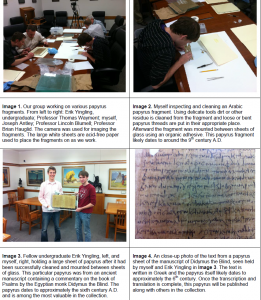Joseph Trevor Antley and Dr. Lincoln Blumell, Ancient Scripture
Currently approximately 80% of the hundreds of ancient papyrus, parchment, and ostracon fragments contained in the L. Tom Perry Special Collections of BYU’s Harold B. Lee Library have been successfully preserved by myself and the others who worked on this project with me, ensuring that these valuable pieces will survive in-tact for many more years in BYU’s collection. The remaining 20%, mostly consisting of very small fragments, will be preserved by us over the coming year.
The project began when myself, fellow undergraduate Erik Yingling, my faculty mentor Lincoln Blumell, and Professor Thomas Wayment (all visible in Image 1) traveled to the University of Berkeley-California to be instructed by their conservation team on how to appropriately handle and preserve the ancient texts in the BYU collection, including the appropriate and differing methods dealing with papyrus as opposed to parchments, etc. While at Berkeley we examined several of the fragments in their collection as well.
The actual process of preserving the documents depended partly on the document’s medium, as different methods had to be used depending on the type of document (whether made from papyrus, parchment, or clay) and how fragile each independent piece was. For the papyrus and parchment fragments, the ultimate goal was to layer them between sheets of glass in order to ensure that they are no longer bent, which can damage the document (previous to our work most of the fragments had been lying loose in boxes or folders, although some of the more valuable ones had been sealed in plastic, bendable sleeves). The documents were adhered to the glass sheets using an organic, homemade adhesive designed to leave no lasting imprint or damage on the fragment.
Because of the previous manner in which these fragments had been stored over the past few decades, several of the pieces had been slightly damaged while at BYU. Many of the parchment fragments, which are made from dried and stretched animal skins, had been crumpled and were often very brittle, and so great care had to be taken in order to straighten them (a process made more difficult by the fact that moistening parchment with water can often bleach it, something we obviously needed to avoid). Prior to our work, because of either crumpling, dirt or other ancient residue, or some other factor, much of the text on these fragments was not legible and had therefore likely never been read in the modern age. Through our work significant new portions of these Greek, Arabic, and Coptic texts are now readable.
Over the summer of 2011 the HBLL also held a special exhibit in the library atrium entrance where they displayed several of our pieces, included the Didymus the Blind fragment pictured below (Image 3). This was in lieu with last year’s conference of the American Society of Papyrologists held at BYU where numerous visiting scholars from around the world came to the university and examined the fragments we had preserved. I personally was able to sit and talk with several of these scholars as they examined our newly-preserved fragments.
Aside from the direct preservation, we also imaged all of the papyri, parchments, and ostraca in the collection in order to give scholars easier access to the texts without them having to handle them directly. These images will be included among the fragments that will be published. There are currently plans to publish the texts in the collection over the coming years, as well as present some of the more significant new finds at academic conferences. Several of the pieces were presented at the regional SBL conference in March 2011.

